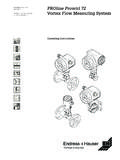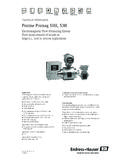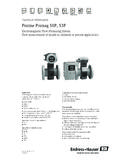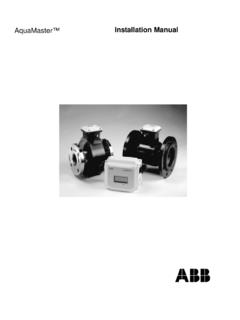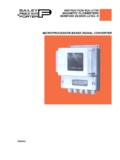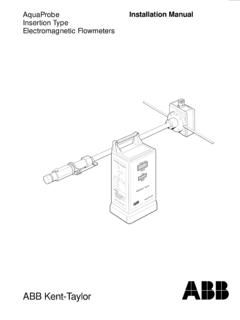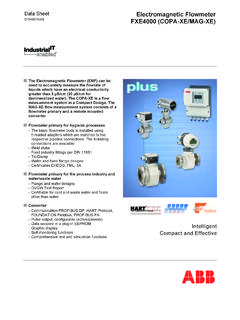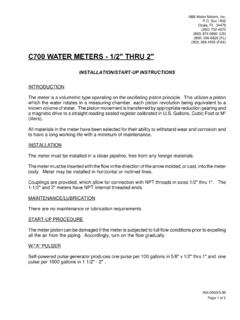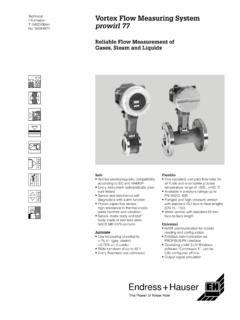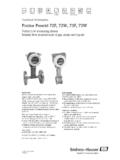Transcription of Prowirl 72F, 72W, 73F, 73W - Controls Warehouse
1 TI00070D/06/ InformationProline Prowirl 72F, 72W, 73F, 73 WVortex flow measuring systemReliable flow measurement of gas, steam and liquidsApplicationFor the universal measurement of the volume flow of gases, steam and mass flow of steam, water (as per IAPWS-IF97 ASME), natural gas (as per AGA NX-19/AGA8-DC92 detailed method/AGA8 Gross Method 1/SGERG-88), compressed air, other gases and liquids can also be calculated with the aid of integrated temperature measurement and by reading in external pressure values ( Prowirl 73).Maximum range of applications thanks to: Fluid temperature range from 200 to +400 C ( 328 to +752 F) Pressure ratings up to PN 250/Class 1500 Sensor with integrated (optional) diameter reduction by one line size (R Style) or two line sizes (S Style) Dualsens version (optional) for redundant measurements with two sensors and electronicsApprovals for: ATEX, FM, CSA, TIIS, NEPSI, IEC HART, PROFIBUS PA, FOUNDATION Fieldbus Pressure Equipment Directive, SIL 2 Your benefitsThe robust Prowirl sensor, tried and tested in over 200 000 applications, offers.
2 High resistance to vibrations, temperature shocks, contaminated fluids and water hammer No maintenance, no moving parts, no zero-point drift ("lifetime" calibration) Software initial settings save time and costsAdditional possibilities: Complete saturated steam or liquid-mass measuring point in one single device Calculation of the mass flow from the measured variables volume flow and temperature in the integrated flow computer External pressure value read-in for superheated steam and gas applications External temperature value read-in for delta heat measurementProline Prowirl 72F, 72W, 73F, 73W2 Endress+HauserTable of contentsFunction and system design.. 3 Measuring principle .. 3 Measuring system.
3 7 Input .. 8 Measured variable .. 8 Measuring range .. 8 Input signal .. 10 Output .. 11 Output signal .. 15 Signal on alarm .. 16 Load .. 17 Low flow cut off .. 17 Galvanic isolation .. 17 Power supply .. 18 Electrical connection .. 18 Wiring HART input .. 18 Wiring remote version .. 19 Supply voltage .. 19 Cable entries .. 19 Cable specifications .. 19 Power supply failure .. 19 Performance characteristics.. 20 Reference operating conditions .. 20 Maximum measured error .. 20 Repeatability .. 21 Reaction time/step response time .. 21 Influence of ambient temperature .. 21 Operating conditions: installation .. 22 Installation instructions .. 22 Inlet and outlet run.
4 25 Operating conditions: environment .. 27 Ambient temperature range .. 27 Storage temperature .. 27 Degree of protection .. 27 Vibration resistance .. 27 Electromagnetic compatibility (EMC) .. 27 Operating conditions: process .. 28 Medium temperature range .. 28 Medium pressure .. 29 Pressure loss .. 31 Mechanical construction .. 32 Design, dimensions .. 32 Weight .. 51 Material .. 51 Human interface .. 53 Display elements .. 53 Operating elements (HART) .. 53 Remote operation .. 53 Certificates and approvals .. 53CE mark .. 53C-tick mark .. 53Ex-approval .. 53 Pressure measuring device approval .. 54 Certification FOUNDATION Fieldbus .. 54 Certification PROFIBUS PA.
5 54 Other standards and guidelines .. 54 Functional safety .. 55 Ordering information.. 56 Accessories .. 58 Device-specific accessories .. 58 Measuring principle-specific accessories .. 58 Communication-specific accessories .. 60 Service-specific accessories .. 61 Documentation .. 62 Registered trademarks .. 62 proline Prowirl 72F, 72W, 73F, 73 WEndress+Hauser3 Function and system designMeasuring principleVortex meters work on the principle of the K rm n vortex street. When fluid flows past a bluff body, vortices are alternately formed on both sides with opposite directions of rotation. These vortices each generate a local low pressure. The pressure fluctuations are recorded by the sensor and converted to electrical pulses.
6 The vortices develop very regularly within the permitted application limits of the device. Therefore, the frequency of vortex shedding is proportional to the volume calibration factor (K-factor) is used as the proportional constant:A0003939-en Within the application limits of the device, the K-factor only depends on the geometry of the device. It is independent of the fluid velocity and the fluid properties viscosity and density. In this way, the K-factor is also independent of the type of matter that is to be measured, regardless of whether this is steam, gas or liquid. The primary measuring signal is already digital (frequency signal) and linear to the flow. After production, the K-factor is determined in the factory by means of calibration and is not subject to long-term or zero-point drift.
7 The device does not contain any moving parts and does not require =PulsesUnit Volume [dm ] proline Prowirl 72F, 72W, 73F, 73W4 Endress+HauserThe capacitive sensorThe sensor of a vortex flowmeter has a major influence on the performance, robustness and reliability of the whole measuring system. The robust DSC sensor with an integrated temperature measurement (Pt 1000) with Prowirl 73 is burst-tested and vibration and temperature-shock-tested (temperature shocks of 150 K/s). The Prowirl uses the tried-and-tested capacitive measuring technology of Endress+Hauser applied in over 200 000 measuring points DSC (differential switched capacitance) sensor patented by Endress+Hauser has complete mechanical balancing.
8 It only reacts to the measured variable (vortex), not to vibrations. Even in the event of pipe vibrations, the smallest of flows can be reliably measured at low density thanks to the unimpaired sensitivity of the sensor. Thus, the wide turndown is also maintained even in the event of harsh operating conditions. Vibrations up to 1 g, in frequencies up to 500 Hz in every axis (X, Y, Z), do not affect the flow measurement. Due to its design, the capacitive sensor is also particularly mechanically resistant to temperature shocks and water hammers in steam lines."Lifetime" calibrationExperience has shown that recalibrated Prowirl devices exhibit a very high degree of stability compared to their original calibration: The recalibration values were all within the original measuring accuracy specifications of the tests and simulation procedures carried out on devices by filing away the edges of Prowirl 's bluff body found that there was no negative impact on the accuracy up to a rounding diameter of 1 mm ( ").
9 Generally the following statements are true: Experience has shown that if the fluid is non-abrasive and non-corrosive ( most water and steam applications), the meter's edges will never show rounding at the edges that is 1 mm ( ") or more. If the rounding of the meter's edges is always 1 mm ( ") or less, the meter will never show a calibration shift that is out of the meter's original specifications. Typically, the bluff body's edges exhibit a small rounding that is less than 1 mm ( "). The meter, however, is calibrated with this rounded edge. Therefore, the meter will stay within the tolerance specifications as long as the additional wear and tear of the edge does not exceed an additional 1 mm ( ").
10 Thus, the Prowirl product line offers calibration for life if the measuring device is used in non-abrasive and non-corrosive DSC sensor, Prowirl 72A0004056-enDSC sensor, Prowirl 73 with integrated temperature sensor (Pt 1000)SensorSealY-AxisX-AxisZ-AxisSensorY -AxisX-AxisZ-AxisPt 1000 proline Prowirl 72F, 72W, 73F, 73 WEndress+Hauser5 Sensor with integrated nominal diameter reductionIn many applications, the nominal diameter of the customer's pipe does not correspond to the nominal diameter that is optimum for a vortex meter as the flow velocity is too low for vortex formation after the bluff body. This is expressed in a signal loss in the lower flow range. To reduce the nominal diameter by one or two steps, and thus increase the flow velocity, it is common practice nowadays to fit such measuring points with the following adapters: Reducer (a) Straight pipe segment (b) as the inlet run (min.)

